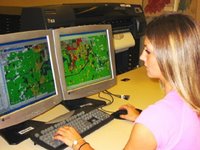 Scavenger Hunters in the GCMC
Scavenger Hunters in the GCMCEnglish 104 students in Elizabeth Nesbitt's classes were given an assignment to complete a scavenger hunt in Bracken Library. Students were asked to cite different materials found in the Library, and part of the assignment included citing a map that was related to their college major. Many of the students were surprised to find such a large variety of topics covered by maps and atlases in the Geospatial Center & Map Collection and Atlas Collection.
Students majoring in history and political science found hundreds of maps and atlases related to their majors. Many of the history students chose to cite actual maps dating from World War II. Others were interested in looking at maps about the Civil War, westward expansion, or Vietnam. A map showing the results of all of the presidential elections was a popular choice with political science students. Some students cited maps included in the
Atlas of American Politics.
Sociology and anthropology students asked for maps related to Native Americans, life in ancient Egypt, or maps related to world religions. Science and natural resources and environmental management students were interested in maps about endangered species, water conservation, and a map of wildlife refuges. A student studying to become a meteorologist requested the map,
Most Intense Tropical Storms of 1998. Some science students cited the map titled
Earth at Night, but this map was also cited by economics students since the lights of the map show development.
A music student cited the
Titanic Reference Map since the map discusses the music played on the ship. An art student cited a map found in the
Atlas of Western Art History. English and writing majors cited the
Map of the Limberlost, a map showing American folklore characters, a map about the Harlem Renaissance,
Shakespeare's Britain, and the
Literary Map of Indiana.
Sports management students cited maps from atlases on sports or specifically golf or the
Soccer Unites the World or the
Baseball Travel Map. A construction student cited a map about the architecture of Rome. Nursing students discovered many maps and atlases related to health issues. Many of the students used atlases for the assignment.
The Tobacco Atlas includes many maps related to health and health education. Some of the students used maps in the atlas showing tobacco deaths, female smokers, and youth smokers, and maps showing where education is provided to help smokers quit.
Another atlas was used by students in nearly every major.
The State of the World Atlas by Dan Smith includes maps about life expectancy at birth, quality of life, investment, world markets, debt, literacy, religion, health risks, reproductive rights, communication and media around the world, and biodiversity. So this atlas proved popular with students searching for a map related to many different types of issues related to many different majors.
This assignment not only taught students about how to use the library and write bibliography citations, but also provided an opportunity to learn about all the different resources the library has available for further research and learning. Please contact the Geospatial Center & Map Collection if interested in planning an assignment for the classroom.
 ...and More Maps from Google
...and More Maps from Google





